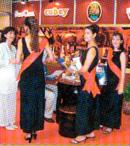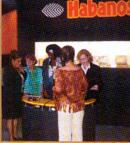FIHAV 2003
The 21st edition of the Havana International Fair (FIHAV 2003) stood for the tradeshow's coming of age as far as quality and professionalism are concerned. The event can now be labeled as an ideal setting for good businesses.
As many as $150 million worth of contracts were signed during the fair, plus a number of letters of intentions that amounted to $17 million in all. Cuba's Vice Minister of Foreign Trade Pedro Luis Padron explained that the recently concluded fair embraced an exhibiting surface of 13,000 square yards, it lured a number of local trade firms to attend the event, served as a launching pad for an array of brand-new products, and fostered exchanges between local and foreign businesspeople.
Over a dozen official delegations and representatives from some twenty foreign chambers of commerce visited the fairgrounds, a signal –experts say- that serious negotiations were going on there and that the tradeshow keeps on netting ever-growing importance with each passing year.
The attendance of a newcomer like Thailand and the presence of a larger delegation from Brazil –a country that had a pavilion of its own for the first time ever- Argentina, China and the United States, helped make the event a blockbuster and somewhat offset a lesser European turnout this time around.
Nonetheless, Europe extended its attendance streak with France and Germany displaying pavilions of their own. Madrid's Chamber of Commerce and a number of Spanish regions, like Malaga, crowded the premises. Italian companies, for their part, were among the firms that cut the most deals.
The list of upcoming events for 2004 –unveiled within the framework of FIHAV- includes such standouts as the International Rum Festival (scheduled for Havana's colonial fortress of La Cabaña from June 6 to 9) and Coral Negro's Fifth Jewel Auction set for February 25 to 28 at Cuba's National Hotel. All jewels will be sold under the gavel on the 28th at the hotel's Taganama Hall.
Cuba put on quite a show for this year's FIHAV with presentations that swayed from its traditional items (rum, cigars and nickel) to an increasingly larger sample of products dealing with heavy metal industries and information technology.
The diversification of Cuban exports is laying solid grounds with the appearance of dozens of biotechnological products, some 200 sanitary registers in over 50 countries and 500 patents requested in a number of markets worldwide.
CUBA GRABBED THE MOST AWARDS Cuban companies walked off with the lion's share of Gold Medals for Product Quality during this year's FIHAV with a grand total of 34. Some of the most outstanding firms were Argus –a partnership of entities linked to the fishing industry- and its Havana Cat Day catamarans. Other products that scooped prizes were Tinima's beers and malts, UNICEF Intercer, Suchel Tropical's fragrances, and the Excorde Hipermax ambulatory screening system.
The runner-up spot went to Spain with seven gold medals, followed by Russia with two, and Italy, Venezuela and the United States with one apiece.
In the category of Design and Publicity, Palmares from the Cubanacan Group nabbed the big prize.
Five firms snared awards in the category of Modular Stand, and three of them were from the turf: ETECSA, Internacional Cubana del Tabaco (ICT) and Los Portales.
The winners in the Free Stand Design category were companies from South Korea, Russia, Mexico and Cuba's Brascuba and Havana Club International.
Among pavilions, the top award went to Brazil. CIMEX Corp. and ALIMPORT –both from Cuba- got special recognition awards.
NEW STUFF AT FIHAV Cuba's Ministry of Foreign Trade (MINCEX) got hooked up to the Internet with a new portal available on www.mincex.cu. Oleana Navas, of the MINCEX's Center for the Promotion of Exports, indicated this new portal allows her ministry to take a strong step forward into the realm of e-commerce.
Mrs. Navas' center also unveiled the new edition of the 2003-2004 Export Directory, a must-read document for those interested in getting as much information as they need on Cuba's exportable items and services.
Another novelty at this year's FIHAV edition was the Cuba-Caribbean Forum organized by the Center for the Investment Promotion (CPI) of the island nation's Ministry of Foreign Investment and Economic Collaboration. The event was attended by 60 professionals from more than a dozen countries, chiefly from Latin America and the Caribbean.
The abovementioned forum was attended by Danilo Rosario Valdez, secretary of state and executive director of the Exports and Investment Center of the Dominican Republic. Mr. Valdez said the possibilities of the Grand Caribbean were mapped out since the 1970s and that explains why countries in the region are now edging closer to integration.
The Dominican Republic counts on 60,000 rooms scattered in 550 top-notch hotels at a time when the Caribbean nation has managed to jump from the sun-and-beach travel modality to a much trendier adventure and nature tourism.
Cuba's ALIMPORT Co. inked contracts for as many as $80 million with U.S. firms, regardless of an inexistent regular trade flow between both nations as a result of the 40-plus-year-old embargo the White House has kept on Cuba.
The USA Rice Federation is putting out all the stops for clinching regular and fair trade ties with the island nation. In a press conference held during FIHAV, Federation authorities revealed that Cuba, formerly the number-one purchaser of American rice between 1956 and 1959, is now inching back up to the top spot. In the first eight months of 2003, Cuba bought 86,000 tons of the cereal from U.S. producers. Rice is an indispensable dietary element in any Cuban household.
ALIMPORT president Pedro Alvarez suggested that Cuba could buy up to 300,000 tons of rice from U.S. companies every year. In all, America exports 3.2 million tons of the grain on a yearly basis. Cuba's potential purchases in the United States –Mr. Alvarez went on to say- could be pulled off without neglecting the island nation's commitments with other suppliers like China and Vietnam.






































































